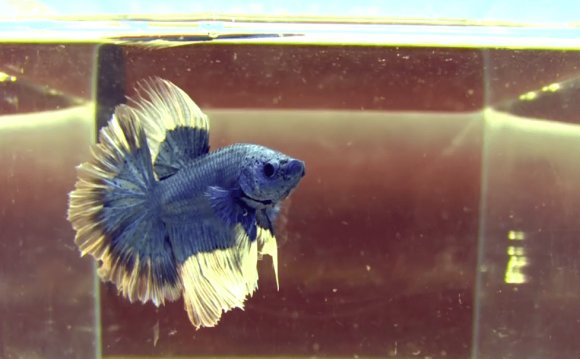
 I would be remised not to mention one of the most popular and easiest species of tropical fish kept today. Betta fishes are from the freshwater family Belontiidae, and the most common species often found in the aquarium is Betta splendens (also referred to as Siamese Fighting Fish). Bettas offer the beautiful coloration similar to marine fishes, but with the ease of minimal filtration and limited aquarium space. Oftentimes, a single Siamese Fighter is found content in a goldfish bowl or small aquarium with little or no filters installed.
I would be remised not to mention one of the most popular and easiest species of tropical fish kept today. Betta fishes are from the freshwater family Belontiidae, and the most common species often found in the aquarium is Betta splendens (also referred to as Siamese Fighting Fish). Bettas offer the beautiful coloration similar to marine fishes, but with the ease of minimal filtration and limited aquarium space. Oftentimes, a single Siamese Fighter is found content in a goldfish bowl or small aquarium with little or no filters installed.
Native to Thailand, these fish have been successfully bred, and reared in the aquarium since the mid 1800's, and also used in sporting bouts since that time. Bettas are notorious for fighting to the death if kept together, and unfortunately, have been exploited for these purposes. Early breeding of the fish focused on the pugnacious temperament and beautiful coloration of the species; the ingredients for a nasty fish fight. So, the modern-day Betta has had over a century of selective breeding to bring out the best and worst of these incredible freshwater fishes. It's probably here that I should mention that two male Siamese Fighters should never be kept together in the same aquarium. :)
The most commonly kept male Siamese Fighter is brightly colored (often found in striking red, blue, turquoise, yellow, and other variations). He boasts flamboyant finnage, which can be a nuisance in a community aquarium, and usually don't do well with other fish, including one another. Their fins are often a brightly colored target, and become shredded apart if kept with others, especially with respect to the fin-nippers such as tetras or barbs. The male Siamese fighter grows to a maximum size of about 2 1/2 inches.
The female Siamese Fighter is smaller, and duller in color her mate. Their fins are are also considerably shorter, but they do have similar coloration patterns as the male. Oftentimes, the female will have mild striping along the sides of her body. She grows to a maximum size of about 2 inches. Although she doesn't get the size or color, the female often will outlive the male by several months. The average lifespan of a Betta is about 2 to 3 years.
These fish are considered very hardy, and as mentioned above, and they are also a sedentary fish, so they only require a small container, or aquarium to be kept. Since they are often kept alone, the aquarium does not take long to stabilize and the tank can be kept without filtration or with a small sponge filter powered by an air pump. Some tanks are kept without substrate for ease of maintenance. Weekly partial water changes are often required to keep these fish happy and healthy. Bettas will eat pelletted and flaked foods, as well as forms of live food such as artemia.. They have recently been observed being sold by pet stores with the misconception that the Betta will live off of plants, and the roots of plants. It's important to note (thanks Anthony) that Bettas are carnivorous, not herbivorous, or omnivorous, so they do require a "meaty", protein-rich diet for their long term health.
Most Bettas can withstand a moderate range of temperature and pH changes, but do require fairly good water quality for breeding...









